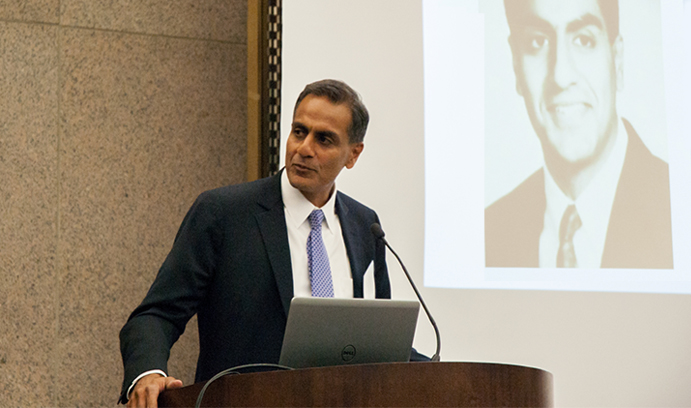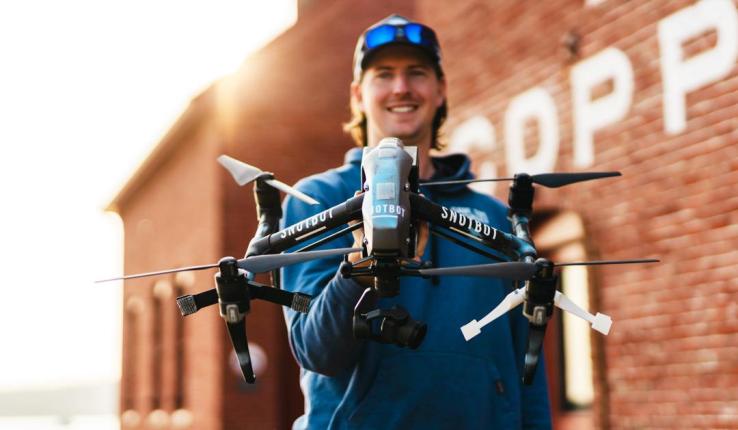Technology’s growing importance to diplomacy

Verma delivers the Schantz Lecture after receiving the 2016 Distinguished Alumni Award in Industry from the industrial and systems engineering department.
Richard Verma ’90 freely admits that he struggled with his major field, industrial engineering, when he was an undergraduate student at Lehigh nearly three decades ago.
“Industrial engineering,” Verma said here last week, “didn’t come naturally to me. I was challenged every day; it was a real workout. The training, the regimen and the rigor at Lehigh are hard to find at other places.”
Today, Verma is the United States ambassador to India and he takes every opportunity he can to stress the importance of science and technology in the fast-growing and warming relationship between the world’s two largest democracies.
“The United States and India are naturally compatible in many areas,” said Verma. “In our bilateral relationship, we need to take two tracks—the track of diplomacy and international relations and the track of science and technology—and try to blend them together.
“Taking one track without the other won’t address the needs that people have. Bringing them together can have the greatest social impact and help achieve innovation on pressing problems like clean energy and healthcare, cybersecurity and space.”
Verma, who was appointed to his position in 2014 by President Barack Obama, visited Lehigh on Thursday (April 28) to deliver the Spencer C. Schantz Distinguished Lecture, which is sponsored by the department of industrial and systems engineering. The department also presented him with its 2016 ISE Distinguished Alumni Award in Industry.
About 150 students and faculty and staff members attended the Schantz Lecture, which Verma titled “Technology, Innovation and American Diplomacy in the 21st Century.”
Verma’s visit to his alma mater was brief: He arrived at Lehigh on Thursday after spending all of Wednesday in Washington, D.C., where he took part in meetings to prepare for the state visit to the U.S. in June by Indian Prime Minister Narendra Modi. On Friday morning, Verma drove to the U.S. Army War College in Carlisle, Pennsylvania, to speak to 100 senior officers. He then flew to Eielson Air Force Base in Alaska to attend Red Flag-Alaska, a series of military exercises involving the air forces of the United States, India and other countries.
The fast pace of activities is one to which Verma has become accustomed as ambassador. In 16 months in India, he has visited 52 Indian towns and cities in 21 states. The ambitious schedule, he said, enables him to see first-hand many examples of U.S.-Indian cooperation.
“Science, technology, and innovation have played an especially vital role in bringing our countries closer together,” he said. “Our cooperation is deeper and more expansive than ever before.”
The examples of India-U.S. cooperation that Verma cited include:
• Bilateral trade has grown to $100 billion a year from $5 billion in 1990. Former presidents Bill Clinton and George W. Bush both played key roles in improving relations, Verma said, and liberalization has helped India’s economy become the fastest-growing major economy in the world.
• Sales of U.S. military hardware to India, which now has the world’s third largest military, exceeded $13 billion in 2015. U.S.-India military cooperation includes regular and complex exercises; those at Eielson, said Verma, are “the most complex to date.”
• Both nations have spacecraft orbiting Mars, and each supports the other’s missions with navigational and technical support. The bilateral Mars Working Group, said Verma, “is working to deepen our understanding of the red planet and beyond.”
• NASA and the Indian Space Research Organization are collaborating on a Synthetic Aperture Radar (SAR) mission that will measure the earth’s most complex processes, including earthquakes, tsunamis, volcanoes and landslides. The mission is scheduled for launch in 2021 on an Indian rocket.
• The two nations have agreed to build a LIGO (Laser Interferometer Gravitational-wave Observatory) station in India to study gravitational waves, black holes and supernovas.
• Science for Society, an Indian nongovernmental organization, has developed a Solar Conduction Dryer (SCD) that preserves fruits and vegetables. In a pilot test in the state of Maharashtra, the technology helped farmers increase sales of dehydrated produce and boost their average annual income by $1,000. Science for Society is funded through the Millennium Alliance, a public-private partnership with the U.S. Aid for International Development that supports innovators in an effort to end extreme poverty, Verma said.
• Verma co-chairs the PACEsetter Fund, which is part of the Partnership to Advance Clean Energy and is a U.S.-India collaboration to develop renewable energy and provide power to the 250 million Indians living without electricity. BioLite, a start-up supported by PACEsetter, develops products “that make cooking with wood as clean and safe as modern fuels while providing electricity to charge cell phones and LED lights off-grid,” Verma said.
Verma, who attended Lehigh on an Air Force ROTC scholarship, later earned a law degree from American University and an international law degree from Georgetown Law Center. More recently, he served as assistant secretary of state for legislative affairs under former Secretary of State Hillary Clinton. He led the Obama administration’s negotiations with Congress for new sanctions on Iran while working for passage of the New START nuclear arms treaty with Russia. He received the Distinguished Service Medal, the State Department’s highest civilian honor.
Verma said Robert H. Storer, professor of industrial and systems engineering, had been a valuable mentor. He also praised Barbara Turanchik, director of club sports and former director of the Lehigh Alumni Association, for her work on behalf of students.
In the department of international relations, where he earned a minor, Verma cited Rajan Menon, a former professor who is now the Anne and Bernard Spitzer Chair in Political Science at the City College of New York.
“Raj had a wonderful style of teaching and he assigned a broad selection of required reading,” said Verma. “He challenged people to think differently.”
Other positive influences at Lehigh, Verma said, included the officers of the Air Force ROTC program, his friends at Lambda Chi fraternity and, while he served as senior class president, former Lehigh President Peter Likins.
Verma was asked how he would advise students today who might find their science or engineering courses difficult to master.
“Don’t be afraid to ask questions and get help,” he said. “The professors here are great at working with students who need a deeper dive. I certainly took advantage of that. And don’t get frustrated at other students’ success. We all have different strengths. I was better at the liberal arts but I wanted to do well on the technical side.
“After a while, things might finally click. I remember light bulbs going off in my head each time I got the keys that helped me solve a particular problem.”
Story by Kurt Pfitzer
Photo by Lisa Apazidis ’19
Posted on:




